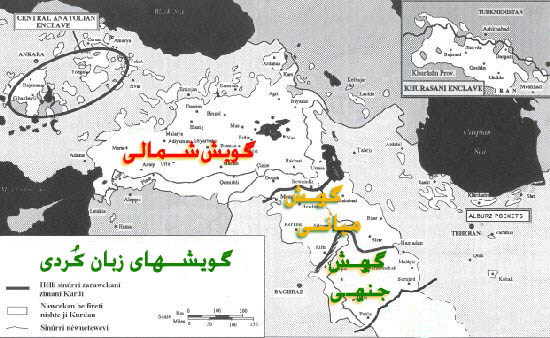Will Yekgirtú compromise the valuable treasures of Kurdish litterateurs produced already in Arabic based writing system?
Will Yekgirtú compromise the valuable treasures of Kurdish litterateurs produced already in Arabic based writing system?
Will Yekgirtú compromise the valuable treasures of Kurdish litterateurs produced already in Arabic based writing system?
 Do you think that using a Latin based unified writing system such as Yekgirtú will compromise the valuable treasures of Kurdish litterateurs produced already in Arabic based writing system?
Do you think that using a Latin based unified writing system such as Yekgirtú will compromise the valuable treasures of Kurdish litterateurs produced already in Arabic based writing system?
This is an issue has often been brought up by the Kurdish linguists and scholars as well as senior users of the Arabic-based Kurdish writing system. It has also been used as the core argument against any reform of the current Kurdish writing systems.
A crucial step in implementing any cultural reform is the gradual implementation and a clear road map, where the target group ought to be the coming generations rather than present one. This means that the future generation(s) should be the one finding itself in a reformed education system and become the first generation that will experience the unified writing system and not the present generation. But nor will a unified Latin based system will not compromise the authenticity of the Kurdish literature.
Fortunately, there are some vital elements at this moment in history that allow for a smooth and painless transition, namely:
- A majority of Kurdish speakers are illiterate in their mother tongue.
- The Kurdish literature, despite its treasures, is relatively young and its literature largely oral , compare to other literate languages surrounding Kurdish, with the exception of Turkish (which is younger and has already gone through transition into Latin-based alphabet change).
- Being a divided nation, Kurdish does not have a standard education system of its own.
- Kurdish language is a Pluricentric/Multi dialectal language.
- On religious/cultural/historic/Geographical ground the Arabic/Persian language and writing system will always play a role in Kurdistan.
- The electronic communication, education and the new life style will offer great opportunity to those who are literate in the Kurdish unified writing system based on ISO-8859-1.
- The Kurdish literatures of all ages can be digitalised, converted to a unified writing system with relatively small effort. (A conversion tool have been already provided by KAL and it is available one KAL web site. Over 4000 people has already made use of it)
- Under supervision of a capable Kurdistan Academy the regulated usage of this writing system in the media and education bring the branches of Kurdish language to a closer common understanding.
- None of the Kurdish classics were produce using modern Kurdo-Arabic writing system. They are all based on Perso-Arabicwriting system.
- A unified writing system will answer to the most fundamental issues of Kurdish language and pave the way to address others such as grammar, vocabulary and style diversities in a more natural process.
The argument from the opponents of such a reform use the example of the Turkish language experience of converting from Perso-Arbic Ottoman alphabet into a Latin based writing system in late 1920s. When we look at the literacy statistics for Turkey of 1927, out of a total population of 13.648.000 only the 11% of it was literate. This ratio increased to 40 % in 1960; and 77 % in 1985. In 1990 the population over 6 years old was 49.163.110. The literate population was 39.555.483. Numbers of illiterate people were 9.587.981. And the ratio of literates to the total population was 80.46 %.(1) This means at the time the reform was introduced 89% of population could not differentiate between a literacy work written in Arabic or Latin alphabet but the reform could change this in a rapid development and today the majority of populations are literate. The reform allowed the Turkish language to overcome the enormous printing and publishing difficulty with Arabic-based Ottoman alphabet and make use of advanced printing, publishing, and pedagogic experiences of western European to tackle this nation wide illiteracy (2). Nevertheless, Erol Köroğlu author of “Literature in Turkey during World War I” believes that illiteracy among the population was one of the major factor in the fall of the Ottoman Empire. However, today there are over 83000 student and scholars across the Turkey who study the Ottoman literature and masters the Perso-Arabic Ottoman alphabet.
The reform, while not abandoning much of the Ottoman literature, instead it enabled generations to get educated and make use of it, even though the Ottoman literature was heavily influenced by Persian literature in writing, style and content. As the result of the reform the Turkish writing system has its own standard ISO-8859-9 today.
Many renowned Kurdish and non-Kurdish scholars has already expressed their views for suitability of a Latin based Kurdish writing system for Kurdish language in large. The elite literati such as T. Wehbi, C.J. Edmons, Prof D.N. Makenzie, J.A. Bedir Khan, Dr A.R. Haji Marif, Prof V. Minorsky were and Prof A. Hassanpour, Prof J. Nebez, Prof M. Izady, H. Qazi, are among those who advocated/advocating for a Latin Based writing system.
Nevertheless the last poll run by KAL has showed that 53% of 1000 voters prefer a multi dialectal language policy introduced in conjunction to a Unified Latin based writing system. If Kurdistan’s policy makers cannot see the great potential of such a reform, then it will fall onto individuals to promote a culture of writing a unified writing system for Kurdish (as Mír Jeladet Alí Bedr Xan suggested in 1930s). KAL urge all Kurdish speakers to start a self-educating process and write in Kurdish Yekgitú alphabet.
Further study
- Functional Literacy and Information Retrieval in Turkey
- The Turkish Language Reform (In particular the section “The New Alphabet”)
- Orality, Literacy, and the Written Arabic Language
- Turkish literature
Answered by Dr Dilan Roshani



